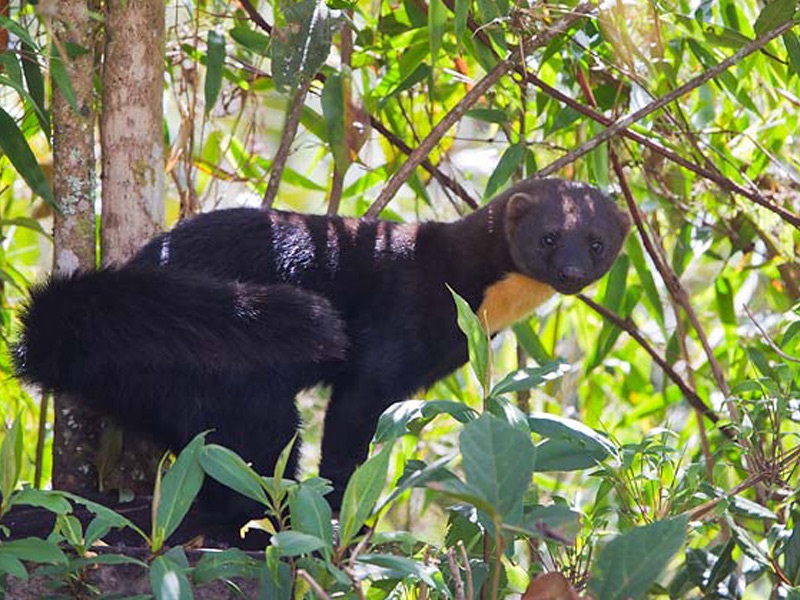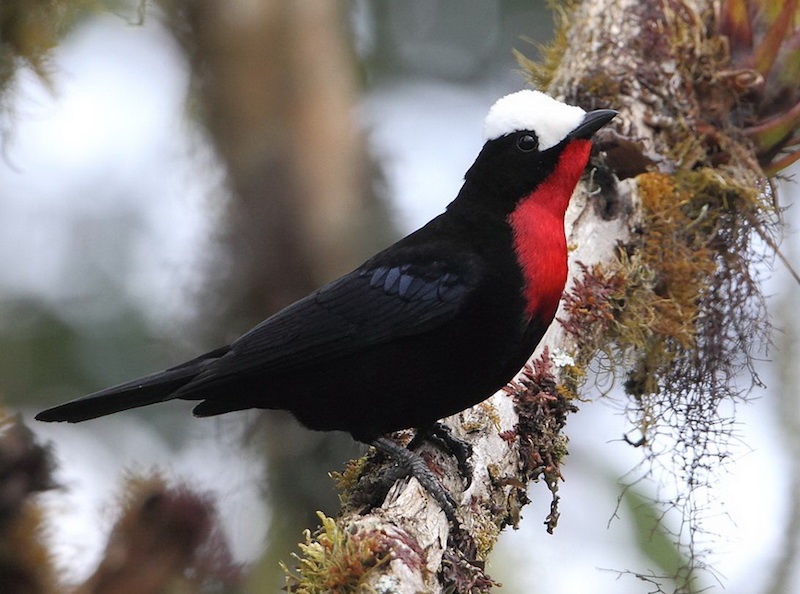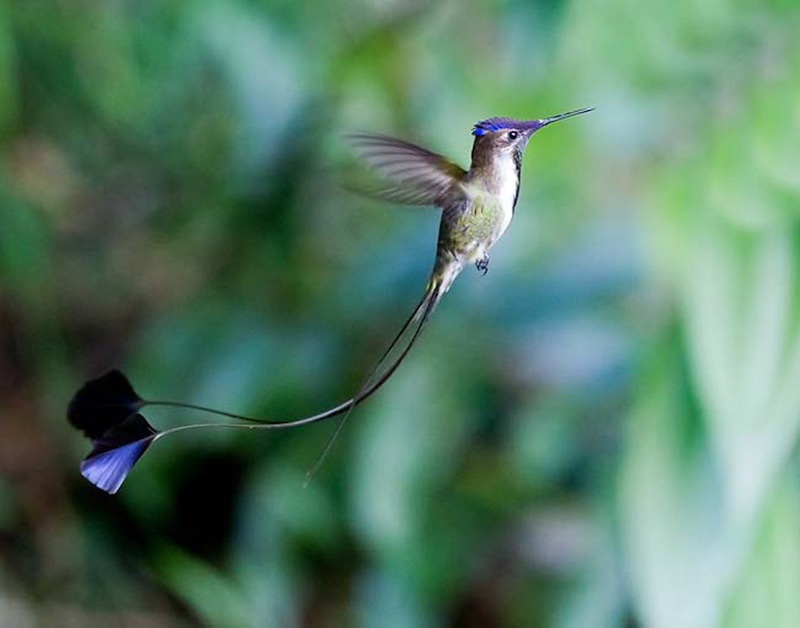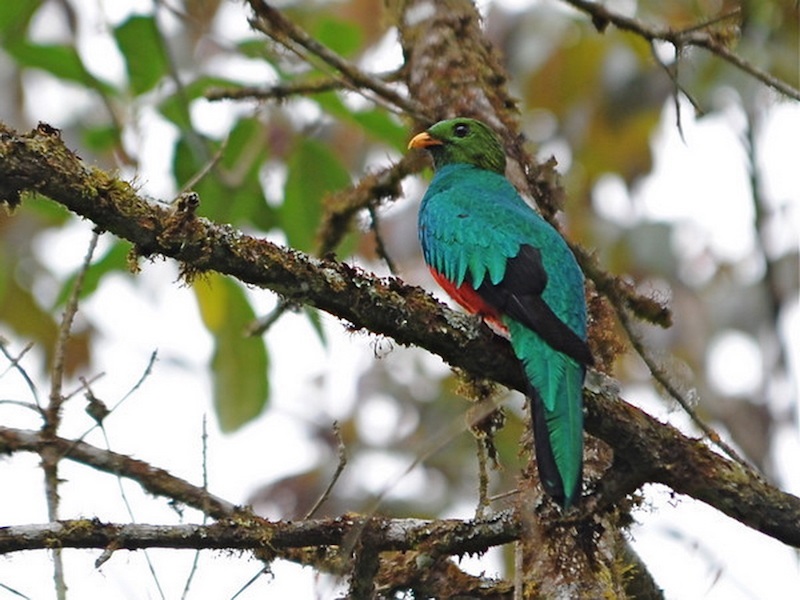Peru is one of the three most diverse countries for birds on Earth and stands at the top of the international birder’s agenda. Its varied geography and topography, and its wildernesses of so many different life zones, have endowed Peru with the greatest bio-diversity and a large density of birds.
There are more than 500 species of mammal, 300 reptiles (a third are endemic) and close to 400 amphibians with more being discovered all the time, so there is plenty for any specialist and an overwhelming variety for the general nature lover. About 1760 bird species occur in Peru (105 being endemic to the country); that’s more than 50% of all Neotropical birds. For ornithologists, it doesn’t come more exciting than this – many species new to science have been discovered in Peru in recent years; some of them so new they have not yet been given scientific names.
Unlike other top-ranking Neo-tropical birding destinations, such as Ecuador and Costa Rica, Peru has vast tracts of forest and wilderness untouched by civilization; two-thirds of the Manu Biosphere reserve, for example, is completely unexplored, hosting un-contacted tribes as well as wildlife. With luck you can still find spectacular mammals like Jaguar and Spectacled Bear not to mention the many armadillos, sloths, anteaters, primates, tapir, deer, opossums, mustelids like the enigmatic Tayra, vicuna and countless rodents and bats.

Peru is, of course, an entomologists dream with hundreds of colourful butterflies, magnificent moths, mammoth beetles and fascinating dragonflies with species numbers virtually countless.
If you are new to Neo-tropical birding, Peru’s potential can be daunting; a four-week trip can produce over 750 species, and some of the identifications can be tricky! Fortunately, there is an excellent field-guide that covers all the birds of Peru. All of Peru’s birding sites cannot be covered in one trip, but the following will give a taste of what this country has in store not only for the exploring birder but of a relaxed nature to a mystical country with rich culture.
Apart from some of the world’s best birding (and as we all know, birding is just an excuse to get us to wild and wonderful places), Peru is just a great place to be. It has unsurpassed scenery, a magnificent history, friendly people, impressive archaeological sites, stunning scenery, and great food.

Below are some of the best birding routes:
Central Peru
This circuit holds a bagful of endemics – though less well known that the North Peru circuit it’s a fantastic trip. First is a stop on the West slope of the Andes which has a suite of endemic birds including Rufous-breasted warbling Finch and Great Inca-Finch, then at area of high Puna grass- and bog-land, about four hours drive east of Lima along the central highway. This is high-altitude birding at its extreme: a giddy 4,500 m.a.s.l. Take it easy here, and drink lots of fluids. Besides regular high Andean species such as ground-tyrants, seed-snipes and sierra-finches, the main reason for birding here istwofold: the Diademed Sandpiper, a rare, almost mythical wader of the mineral-rich marshes, and White-bellied Cinclodes, perhaps the prettiest and one of the rarest of the Ovenbirds. With luck, both can be seen here. Other highlights include and the smart black-breasted Hillstar, a hummingbird endemic to Peru, Dark-winged Miner and Puna Tinamou.
A quick side trip down the Satipo road for a few days will find you some interesting species with four species being very recently described to science including the endemic Junín Tapaculo.
Continuing along the Central Highway, the well-paved road continues another 120 kms. to Lake Junin, where, with prior arrangement, it is possible to hire a boat to see the endemic Junín Flightless Grebe. This lake is also a fantastic place to see all the highland waterbirds and raptors, and the surrounding fields abound with sierra-finches and ground-tyrants.
A further 180 kms. along the highway brings you to Huánuco. This is the base for exploring the Carpish Tunnel area. About one hour’s drive northeast of Huánuco, the road passes through the Carpish range, and birding either side of the tunnel can be very productive. Powerful Woodpecker, Sickle-winged Guan and large mixed feeding flocks appear out of the mist in the epiphyte-laden cloud-forest. The more adventurous may visit an area of tree-line forest which hold sought after endemics such as Golden-backed Mountain Tanager, Bay-vented Cotinga, Pardusco, Neblina Tapaculo and more.
Crossing the Andes from East to West, a spectacular drive, you can finish at the Huascaran National Park, situated in the central Andes, Huaráz is the starting point for excursions. From this base, it is possible to explore the more remote areas of the mountains, such as the lakes of Llanganuco, where, in the surrounding high Andean woodlands, many little-known and interesting birds can be seen. Here, a search may produce that rare mistletoe specialist, the White-cheeked Cotinga, or the endemic Plain-tailed Warbling Finch, whilst a check on the skyline will surely produce an Andean Condor soaring against the breathtaking backdrop of 6,000 ms. snow peaks. Three or four days in this area will produce a wide variety of both grassland and woodland species.
Chiclayo-Cajamarca circuit
Starting at the coastal city of Chiclayo, a long but rewarding trip can be made into the deep Marañon valley and its environs and the Tumbezian endemic zone with its suite of endemic birds. On this route, some of the most sought-after and spectacular of Peru’s birds can be found – legendary species such as the Marvellous Spatuletail, Marañon Crescent-chest, Long-whiskered Owlet,White-winged Guan, Pale-billed Antpitta, Chestnut-baked Thornbird, Buff-bridled Inca Finch, Scarlet-banded Barbet to name but a few. Staying at eco-lodges or nearby hotels in cities, many endemic species and impressive numbers of species are available. This route from being relatively unknown 10 years ago has become a very popular destination.

Iquitos
From this city it is possible to visit a number of rainforest lodges. Some of these are very touristy, but nonetheless good for birds. For the birder, some lodges stand out above the rest: ExplorNapo with its excellent canopy walkway, which is superb for observing tree-top birds, Tahuayo and Muyuna Lodges with river island specialists and varzea forest birds. These lodges are quite expensive but very comfortable. but all lodges in the area are excellent for Amazon birds, especially for the many species that are not seen south of the Amazon river and for river island specialties. The Allpahauayo-Mishana Reserve just outside Iquitos City holds some very rare recently discovered species and is a must.
Machu Picchu & Abra Málaga
Most visitors to Peru visit the southeast of the country, attracted principally by the archaeological sites of the Inca civilization, and the city of Cusco is the starting point for trips in this area for birder and non-birder alike. Nearby Machu Picchu is the major tourist destination – and a nightmare for lovers of peace and solitude. However, the bamboo stands surrounding the ruins provide excellent opportunities for seeing the Inca Wren! Also, a walk along the tracks near the railroad station can produce species which are difficult to see elsewhere such as Sclater’s Tyrannulet and Oleaginous Hemispimgus; this is the place in Peru to see White-capped Dipper and Torrent Duck.
From the town of Ollantaytambo, on the way to Machu Picchu, it is only two hours drive to one of the most accessible native Polylepis woodlands in the Andes, whilst the humid temperate forest of Abra Málaga is only 45 minutes further on. In the polylepis, some very rare birds can be located without too much difficulty, including Royal Cinclodes and White-browed Tit-spinetail (the latter being one of the ten most endangered birds on earth). The humid temperate forest is laden with moss and bromeliads, and mixed species flocks of including multi-colored tanagers are common.
Manu Biosphere Reserve
This is probably the most pristine conservation unit in the world! The reserve itself is over half the size of Switzerland, and much of it is completely unexplored. Un-contacted Amazonian peoples still inhabit the upper reaches of Manu’s forest. The variety of birds is astounding; the reserve holds over 1,000 species – significantly more than the whole of Costa Rica and over one tenth of all the birds on earth. Large mammals such as Jaguar, Giant Otter and Andean Bear also occur at maximum population levels.
Access to Manu is strictly limited, and only authorized operators can take visitors into the park itself. However, there are adjacent areas where one can see all the Manu bird specialties and an astounding variety of other wildlife. A typical trip into Manu starts in Cusco and takes in the wetlands at nearby Huacarpay, where a variety of Andean waterfowl and marsh birds are abundant. Here the endemic and beautiful Bearded Mountaineer Hummingbird can be seen feeding on tree tobacco. Then the route proceeds to the cloud forest of the eastern Andean slopes. Trees are then continuous from the tree-line at 3,300 m.a.s.l. down in to the Amazon basin, and on to the borders of Brazil and Bolivia. Driving slowly down through the cloud forest, every 500 ms. loss of elevation produces new birds. This is the home of the Andean Cock-of-the-Rock, and a visit to one of their leks (courtship sites) is one of the world’s great ornithological spectacles. There are also two species of quetzal here; in fact, these humid montane forests are home to a mind-boggling variety of multi-colored birds; a mixed flock of tanagers, honeycreepers and conebills can turn any tree into a Christmas Tree!

The last forested foothills of the Andes level out into the upper tropical zone, a forest habitat that elsewhere has disappeared, to be replaced by tea, coffee and coca plantations. In Manu the forest is intact, and special birds such as the Amazonian Umbrellabird, and Blue headed and Military Macaws can be found. From here, transport is by river. The beaches are packed with nesting birds in the dry season; Large-billed terns scream at passing boats and Orinoco Geese watch warily from the shore. Huge colonies of Sand-colored Nighthawks roost and nest on the hot sand.
As you leave the foothills and reach the untouched forests of the western Amazon, you enter jungle with highest-density of birdlife per square km. On earth. But beware! – sometimes it seems as if there are fewer birds than in a European woodland; only strange calls betray their presence – until a mixed flock comes through, containing an astonishing 70-plus species; or a brightly colored group of, say, Rose-fronted Parakeets dashes out of a fruiting tree. For the birder who craves the mysterious and rare, this is the site. This forest has produced the highest day-list on foot ever recorded on earth, and it holds such little-seen gems as Black-faced Cotinga and Rufous-fronted Ant-thrush. Antbirds and Ovenbirds creep in the foliage and give tantalizing glimpses until, eventually, they reveal themselves in a shaft of sunlight. To get to this forest is difficult and expensive, but the experience is well worth it.
A trip to Manu is one of the ultimate birding experiences, and topping it off with a macaw lick is a great way to finish; hundreds of brightly colored macaws and other parrots congregate to eat the clay essential to their digestion in one of the world’s great wildlife spectacles.
Tambopata-Candamo Reserved Zone
This area is accessible via the Tambopata river. A number of jungle lodges offer excellent lowland rainforest birding, providing a reasonable alternative for those who do not have the time or money to visit Manu.
Major Source: Fatbirder
Map Source: Googlemaps™
Photo Source: Birding Ecotours
